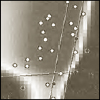|
 |
The central theme of my 1991 doctoral thesis under the guidance
of Elie Bienenstock was the relationship
between neural code and mental representation.
If we make the assumption
that all mental "entities" (sensation, perception, concept,
word, external object, action, etc.) are represented in the
nervous system as states of neuronal activities, a fundamental
problem of cognitive neuroscience is to elucidate the
structure and properties of such representational states.
|
|
I conducted three different, yet interrelated studies
advocating Christoph von der Malsburg's theory of temporal
correlations as the basis of the neural code: a handwritten
character classifier (see
), a model
of cortical self-organization (see
),
and a review of the limits of statistical learning in neural
networks (see ).
|
|
|
|
The bias/variance dilemma in formal neural networks
|
 |
The first part, in collaboration with
Stuart Geman, does not offer a new method
or algorithm but rather aims at bringing to light general
problems and limitations encountered by statistical learning
processes, especially of the generalist or "nonparametric" kind.
The main goal of this study is to stress the crucial importance
of identifying the right format of representation and
giving it priority over other concerns about the "adaptability"
or power of generalization of a learning system.
It became an oft-cited paper published in Neural Computation
in 1992.
|
|
In this work, we addressed the issue of representation within the
framework of statistical estimation theory. During the
renewal of interest for connectionist models in the 1980's,
the great majority of neural network methods focused
on classification or estimation problems, especially regression.
|
|
|
|
Elastic matching for handwritten character recognition
|
 |
We put into practice the first part's recommendation in the
second part by designing a handwritten character classification
method based on order-2 correlations. Images are represented by
2-D deformable lattices instead of unstructured lists of pixels,
while the "distance" between two input images is defined as the
cost-functional of a graph-matching process. The success rates
achieved by this criteria are superior to feed-forward
neural classifiers, implicitly based on Hamming or Euclidean
metrics.
|
|
In this part we described a concrete implementation of a
shape recognition model inspired by von der Malsburg (1981).
This author offers an original representation format in the
nervous system based on an order-2 neural coding.
|
|
|
|
An epigenetic development model of the nervous system
|
 |
The third part approached the issue of neural
representation from a more abstract and speculative viewpoint.
We wanted to address the compositionality
of cognitive processes and language, i.e., the faculty of assembling elementary
constituent features into complex representations.
Answering Fodor and Pylyshyn's (1988) influential criticism
about the lack of structured representations in neural networks,
we showed that compositionality
can arise from the simultaneous self-organization of
connectivity and activity in an initially random network.
|
|
Already apparent in invariant perceptual tasks, where objects
are categorized according to the relationships among their parts,
compositionality is particularly striking in language
and is also referred to as constituency. Language
is often described as a "building block" system, in which the
operative objects are symbols endowed with an internal
combinatorial structure.
|














